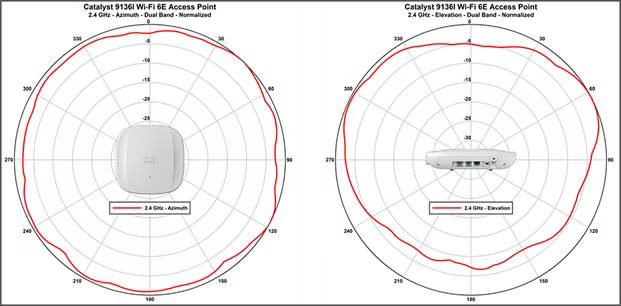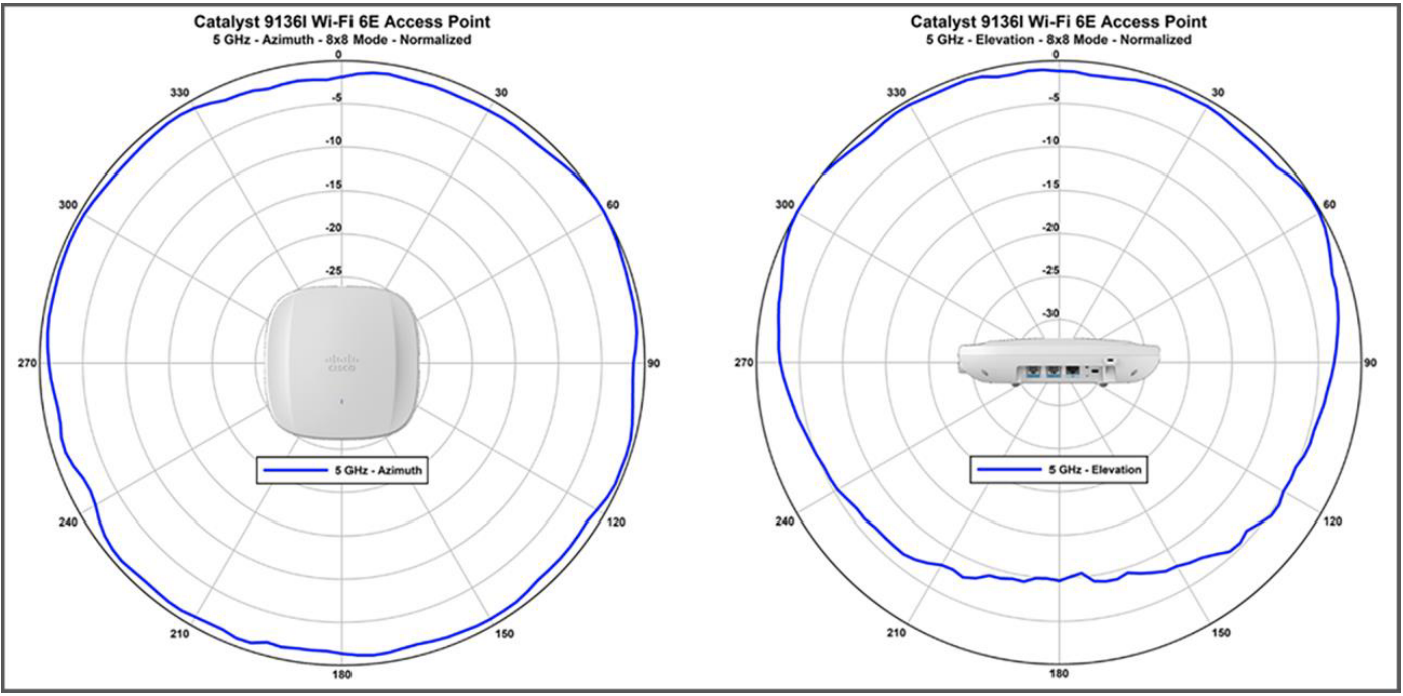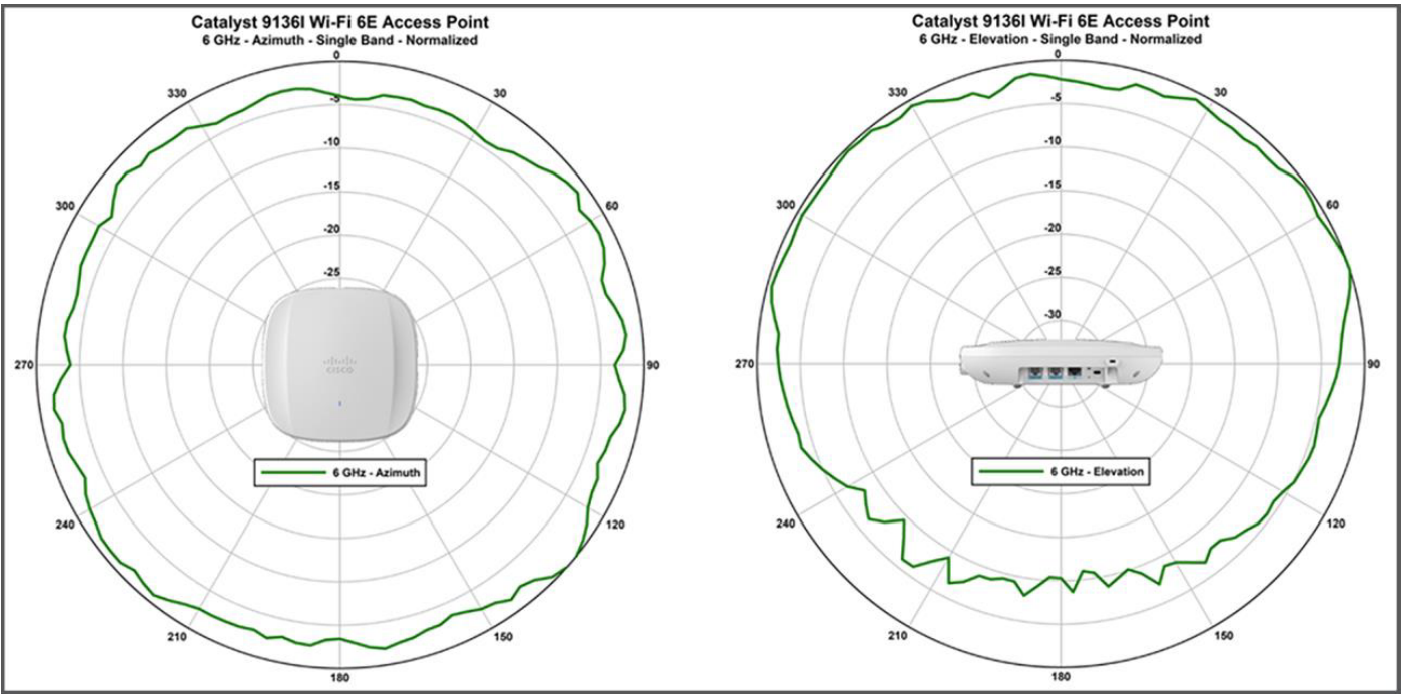
Industry-leading Wi-Fi 6E for large, high-density deployments
- Six radios: 2.4 GHz (4x4), 5 GHz (8x8 and 4x4), 6 GHz (4x4), scanning radio, and BLE/IoT
- Cisco CleanAir Pro for interference-free Wi-Fi
- Dual uplink Ethernet ports for resiliency
- Embedded environmental sensors
The Cisco Catalyst 9136 Series Access Points are the next generation of enterprise access points supporting the new 6-GHz band for Wi-Fi. They are resilient, secure, and intelligent.

- Network speed increases due to the new 6-GHz spectrum and additional bandwidth.
- A new standard of reliability and predictability of connection that is shortening the gap between wireless and wired connections. Wi-Fi 6E devices won’t have to share the same spectrum with any devices that are not Wi-Fi 6E compliant and will have an additional 1.2 GHz of no-interference spectrum to themselves.
- Greater network security than ever before, due to mandatory WPA3 security.
Table 1. Catalyst 9136 Series features and benefits
Feature | Benefits |
Wi-Fi 6E (802.11ax) | The IEEE 802.11ax standard, also known as High-Efficiency Wireless (HEW) or Wi-Fi 6, builds on 802.11ac. It delivers a better experience in typical environments with more predictable performance for advanced applications such as 4K or 8K video; high-density, high-definition collaboration apps; all-wireless offices; and the Internet of Things (IoT). Wi-Fi 6E is Wi-Fi 6 “extended” into the 6-GHz frequency band. |
Environmental sensors | These built-in sensors measure air quality (Total Volatile Organic Compounds [TVOC]), temperature, and humidity, and help ensure a safe working environment, avoiding the need to install an overlay of difficult-to-manage independent sensors. |
Dual 5G Multigigabit Ethernet | Dual Multigigabit Ethernet provides power-redundant uplink ports, each with speeds up to 5 Gbps. All speeds are supported on Category 5e cabling, as well as 10GBASE-T (IEEE 802.3bz) cabling. Redundant powering provides hitless performance during failover. |
Smart AP | Smart AP causes the access point to change its power consumption to reflect its current client load. An access point will typically operate on the radios provided to it irrespective of how many clients are connected. With Smart AP, if there is a small enough number of clients, the access point will automatically reduce the radio stream count, saving power. (Available with a future software upgrade.) |
Band steering | Enhanced to help clients that are 6-GHz capable to leave the 5-GHz radio and connect to the 6-GHz one. Wi-Fi 6E clients are automatically directed to connect to the 6-GHz radio to take advantage of the benefits that that radio offers and free up the 2.4- and 5-GHz radios for legacy clients. |
Uplink/downlink OFDMA | Orthogonal Frequency-Division Multiple Access (OFDMA)-based scheduling splits the bandwidth into smaller frequency allocations called Resource Units (RUs), which can be assigned to individual clients in both the downlink and uplink directions to reduce overhead and latency. |
Uplink/downlink MU‑MIMO technology | Supporting the highest number with 16 spatial streams, Multiuser Multiple Input, Multiple Output (MU-MIMO) enables the access points to split spatial streams between client devices to maximize throughput. |
BSS coloring | Spatial reuse (also known as Basic Service Set [BSS] coloring) allows the access points and their clients to differentiate between BSSs, thus permitting more simultaneous transmissions. |
Target Wake Time | Target Wake Time (TWT) allows the client to stay asleep and to wake up only at prescheduled (target) times to exchange data with the access point. This offers significant energy savings for battery-operated devices, up to three to four times the savings achieved by 802.11n and 802.11ac. |
Intelligent Capture | Intelligent Capture probes the network and provides Cisco DNA Center with deep analysis. The software can track more than 240 anomalies and instantaneously review all packets on demand, emulating the onsite network administrator. Intelligent Capture allows for more informed decisions on your wireless networks. |
Flexible Radio Assignment (FRA) with quad-radio mode (with future software SW upgrade) | FRA allows the access points to intelligently determine the operating mode of serving radios based on the RF environment and traffic demands. The access points can operate in the following modes: ● Tri-radio mode: One 4x4 6-GHz radio, one 8x8 5-GHz radio, and one 4x4 2.4-GHz radio. ● Quad-radio mode: One 4x4 6-GHz radio, Dual 4x4 5-GHz radios, and one 4x4 2.4-GHz radio. With four total 4x4 radios (quad-radio) inside the access point, client device capacity can be increased on demand. The access point’s default mode is tri-radio with 8x8 5-GHz and 4x4 for 6-GHz and 2.4-GHz. It has the ability to split the 8x8 radio into two separate 4x4 5-GHz radios through a future software upgrade, thereby enabling the benefits of FRA while allowing the 2.4- and 6-GHz radios to remain active. |
Application hosting | Application hosting helps simplify IoT deployments and ready them for the future by eliminating the need to install and manage overlay networks. Using the USB interface, containerized applications and hardware modules can be deployed to reduce cost and complexity. Adding Cisco DNA Center provides workflows and deployment-wide application lifecycle management. |
Bluetooth 5 | The integrated Bluetooth Low Energy (BLE) 5 radio enables location-based use cases such as asset tracking, wayfinding, and analytics. |
Container support for applications | Container support enables edge computing capabilities for IoT applications on the host access point. |
For more details about Catalyst 9136 feature support, see Cisco's Feature Matrix.
Secure infrastructure
Trustworthy systems built with Cisco Trust Anchor Technologies provide a highly secure foundation for Cisco products. With the Cisco Catalyst 9100 Access Points, these technologies enable assurance of hardware and software authenticity for supply chain trust and strong defense against man-in-the-middle attacks that compromise software and firmware. Trust Anchor capabilities include:
- Image signing
- Secure Boot
- Cisco Trust Anchor module
Cisco DNA support
Pairing the Cisco Catalyst 9136 Series Access Points with Cisco DNA allows for a total network transformation. Cisco DNA allows you to truly understand your network with real-time analytics, quickly detect and contain security threats, and easily provide networkwide consistency through automation and virtualization. The Cisco Catalyst 9136 Series supports Software-Defined Access (SD-Access), Cisco’s leading enterprise architecture.
Working together, the Catalyst 9136 Series and Cisco DNA offer such features as:
- Cisco Spaces
- Cisco Identity Services Engine
- Cisco DNA Analytics and Assurance along with Intelligence Capture (iCAP)
The result? Your network stays relevant, becomes digital ready, and is the lifeblood of your organization.
Note: For information about Cisco DNA, refer to the Cisco DNA Solution Overview.
Product specifications
Table 2. Specifications
Item | Specification | |||||||
Part numbers | Cisco Catalyst 9136I Access Point: Indoor environments, with internal antennas ● C9136I-x: Cisco Catalyst 9136 Series Regulatory domains: (x = regulatory domain) Customers are responsible for verifying approval for use in their individual countries. To verify approval and to identify the regulatory domain that corresponds to a particular country, visit https://www.cisco.com/go/aironet/compliance. Not all regulatory domains have been approved. As they are approved, the part numbers will be available on the Global Price List and/or regional price lists. Cisco Wireless LAN Services | |||||||
Software | Catalyst 9136I ● Cisco IOS XE Software Release 17.7.1 or later | |||||||
Supported wireless LAN controllers | ● Cisco Catalyst 9800 Series Wireless Controllers (physical or virtual) ● Cisco Catalyst 9k switches with Embedded Wireless Controller in SDA mode | |||||||
802.11n version 2.0 (and related) capabilities | ● 4x4 MIMO with four spatial streams ● Maximal Ratio Combining (MRC) ● 802.11n and 802.11a/g beamforming ● 20- and 40-MHz channels ● PHY data rates up to 1.5 Gbps (40 MHz with 5-GHz and 20 MHz with 2.4-GHz) ● Packet aggregation: Aggregate MAC Protocol Data Unit (A-MPDU) (transmit and receive), Aggregate MAC Service Data Unit (A-MSDU) (transmit and receive) ● 802.11 Dynamic Frequency Selection (DFS) ● Cyclic Shift Diversity (CSD) support | |||||||
802.11ac | ● 8x8 downlink MU-MIMO with eight spatial streams ● MRC ● 802.11ac beamforming ● 20-, 40-, 80-, and 160-MHz channels ● PHY data rates up to 3.4 Gbps (8x8 80 MHz or dual 4x4 80+80 MHz on 5-GHz) ● Packet aggregation: A-MPDU (transmit and receive), A-MSDU (transmit and receive) ● 802.11 DFS ● Cyclic Shift Diversity (CSD) support ● Wi-Fi Protected Access (WPA) 3 support | |||||||
802.11ax | ● 8x8 uplink/downlink MU-MIMO with eight spatial streams (5-GHz) ● 4x4 uplink/downlink MU-MIMO with four spatial streams (2.4 and 6-GHz) ● Uplink/downlink OFDMA ● TWT ● BSS coloring ● MRC ● 802.11ax beamforming ● 20-, 40-, 80-, and 160-MHz channels (6-GHz) ● 20-, 40-, 80-, 80+80-MHz (5-GHz) ● 20-MHz channels (2.4-GHz) ● PHY data rates up to 10.2 Gbps (4x4 160 MHz on 6 GHz, 8x8 80 MHz on 5-GHz, and 4x4 20 MHz on 2.4-GHz) ● Packet aggregation: A-MPDU (transmit and receive), A-MSDU (transmit and receive) ● 802.11 DFS ● CSD support ● WPA3 support | |||||||
Integrated antenna | ● 2.4-GHz: Peak gain 4 dBi, internal antenna, omnidirectional in azimuth ● 5-GHz: Peak gain 5 dBi, internal antenna, omnidirectional in azimuth ● 6-GHz: Peak gain 6 dBi, internal antenna, omnidirectional in azimuth | |||||||
Interfaces | ● 2x 100M/1000M/2.5G/5G Multigigabit Ethernet (RJ-45) ● Management console port (RJ-45) ● USB 2.0 at 9W | |||||||
Indicators | ● Status LED indicates boot loader status, association status, operating status, boot loader warnings, and boot loader errors | |||||||
Dimensions | ● Access point (without mounting brackets): ◦ 9.9 x 9.9 x 2.2 in. (25.1 x 25.1 x 5.6 cm) | |||||||
Weight | Catalyst 9136I ● 3.6 lb. (1.65 kg) | |||||||
Input power requirements | ● 802.3bt Cisco Universal PoE (Cisco UPOE), 802.3at Power over Ethernet Plus (PoE+) ● Cisco power injector, AIR-PWRINJ7= ● 802.3af PoE (only for configuration staging, all radios off) | |||||||
Catalyst 9136I | ||||||||
Power Source | 2.4-GHz radio | 5-GHz radio | 6-GHz radio | Link speed | USB | Max PoE Power Consumption | ||
802.3bt (UPOE) | 4x4 | 8x8 | 4x4 | 2x 5G | Y (9W) | 47.3W | ||
802.3at (PoE+) | 2x2 | 4x4 | 2x2 | 1x 2.5G | N | 24.4W | ||
802.3af (PoE) | – | – | – | 1x 1G | N | 13.95W | ||
Note: Actual power consumption may vary depending on AP usage. It is recommended that you ensure that LLDP/CDP is enabled to allow proper power negotiation. | ||||||||
Environmental | Catalyst 9136I ● Nonoperating (storage) temperature: -22° to 158°F (-30° to 70°C) ● Nonoperating (storage) altitude test: 25˚C (77°F) at 15,000 ft (4600 m) ● Operating temperature: 32° to 122°F (0° to 50°C) ● Operating humidity: 10% to 90% (noncondensing) ● Operating altitude test: 40˚C (104°F) at 9843 ft (3000 m) Note: When the ambient operating temperature exceeds 40°C (104°F), the access point will shift from 8x8 to 4x4 on the 5-GHz radio, and uplink Ethernet will downgrade to a single 1G; however, the USB interface will remain enabled. | |||||||
System memory | ● 2048 MB DRAM ● 1024 MB flash | |||||||
Warranty | Limited lifetime hardware warranty | |||||||
Available transmit power settings | 2.4 GHz ● 23 dBm (200 mW) ● -4 dBm (0.39 mW) | 5 GHz ● 26 dBm (400 mW) ● -1 dBm (0.79 mW) | 6 GHz ● 23 dBm (200 mW) ● -4 dBm (0.39 mW) Note: In countries where use of the 6 GHz band is not allowed or there is no current software support, the 6 GHz radio will be disabled. The radio may be enabled with future software, once the product is certified to operate in 6 GHz for that country. | |||||
Regulatory domains | Note: Customers are responsible for verifying approval for use in their individual countries. To verify approval and to identify the regulatory domain that corresponds to a particular country, visit https://www.cisco.com/go/aironet/compliance. For information about regulatory domain support, refer to the Cisco Regulatory Domain White Paper. | |||||||
Compliance standards | ● Safety: ◦ IEC 60950-1 / IEC 62368-1 Ed.3 (with Ed.2 Deviation annex) ◦ EN 60950-1 / EN 62368-1 Ed.3 (with Ed.2 Deviation annex) ◦ UL 60950-1 / UL62368-1 3rd (with Ed.2 Deviation annex) ◦ CAN/CSA-C22.2 No. 60950-1 / CAN/CSA-C22.2 No. 62368-1 3rd (with Ed.2 Deviation annex) ◦ AS/NZS60950.1 / AS/NZS62368.1 Ed.3 (with Ed.2 Deviation annex) ◦ UL 2043 ◦ Class III equipment ● Emissions: ◦ CISPR 32 (rev. 2015) +AMD1:2019 ◦ EN 55032:2015/A11:2020 ◦ EN IEC 61000-3-2:2019/A1:2021 ◦ EN 61000-3-3:2013+A1:2019 ◦ AS/NZS CISPR32: 2015+AMD1:2020 ◦ 47 CFR FCC Part 15B ◦ ICES-003 (Issue 7, Class B) ◦ VCCI-CISPR 32:2016 ◦ CNS 13438:2006 (95) ◦ KS C 9832:2019 ◦ QCVN 118:2018/BTTTT ● Immunity: ◦ EN 55035:2017+A11:2020 ◦ KS C 9835:2019 ● Emissions and immunity: ◦ EN 301 489-1 V2.2.3 (2019-11) ◦ EN 301 489-17 V3.2.4 (2020-09) ◦ QCVN (18:2014) ◦ QCVN 112:2017/BTTTT ◦ KS X 3124:2020 ◦ KS X 3126:2020 ◦ EN 61000-6-1:2019 ◦ EN 60601-1-2:2015+A1:2021 | ● Radio: ◦ EN 300 328 (v2.2.2) ◦ EN 301 893 (v2.1.1) ◦ EN 303 687 (v0.0.14, draft) ◦ AS/NZS 4268 (rev. 2017) ◦ 47 CFR FCC Part 15C, 15.247, 15.407 ◦ RSP-100 ◦ RSS-GEN ◦ RSS-247 ◦ LP0002 (109) ◦ Japan Std. 66, and Std. 71 ● RF safety: ◦ EN 50385:2017 ◦ AS/NZS 2772 (rev. 2016) ◦ 47 CFR Part 2.1091 ◦ RSS-102 ● IEEE standards: ◦ IEEE 802.3 ◦ IEEE 802.3ab ◦ IEEE 802.3af/at ◦ IEEE 802.11a/b/g/n/ac/ax ◦ IEEE 802.11h, 802.11d ● Security: ◦ 802.11i, (WPA2, WPA3) ◦ 802.1X ◦ Advanced Encryption Standard (AES) ● Extensible Authentication Protocol (EAP) types: ◦ EAP-Transport Layer Security (TLS) ◦ EAP-Tunneled TLS (TTLS) or Microsoft Challenge Handshake Authentication Protocol (MSCHAP) v2 ◦ Protected EAP (PEAP) v0 or EAP-MSCHAP v2 ◦ EAP-Flexible Authentication via Secure Tunneling (EAP-FAST) ◦ PEAP v1 or EAP-Generic Token Card (GTC) ◦ EAP-Subscriber Identity Module (SIM) | ||||||
Certifications | ● Wi-Fi Alliance: Wi-Fi 6 (R2), Wi-Fi 6E, WPA3-R3, WPA3-Suite B, Enhanced Open Security ● Bluetooth SIG: Bluetooth Low Energy | |||||||
Figure 2.
Antenna profiles
Licensing
For information about licensing and packaging, refer to Cisco Licensing.
Warranty information
The Cisco Catalyst 9136 Series Access Points come with a limited lifetime warranty that provides full warranty coverage of the hardware for as long as the original end user continues to own or use the product. The warranty includes 10-day advance hardware replacement and ensures that software media are defect-free for 90 days. For more details, visit https://www.cisco.com/go/warranty.
Cisco environmental sustainability
Information about Cisco’s environmental sustainability policies and initiatives for our products, solutions, operations, and extended operations or supply chain is provided in the “Environment Sustainability” section of Cisco’s Corporate Social Responsibility (CSR) Report.
Reference links to information are below.
Sustainability topic | Reference |
Information on product material content laws and regulations | |
Information on electronic waste laws and regulations, including products, batteries, and packaging |
Cisco does not represent, warrant, or guarantee that it is complete, accurate, or up to date. This information is subject to change without notice.
Cisco Services
With Cisco Services, you can achieve infrastructure excellence faster with less risk. From an initial WLAN readiness assessment to implementation, full solution support, and in-depth training, our services for the Cisco Catalyst 9136 Series provide expert guidance to help you successfully plan, deploy, manage, and support your new access points. With unmatched networking expertise, best practices, and innovative tools, Cisco Services can help you reduce overall upgrade, refresh, and migration costs as you introduce new hardware, software, and protocols into the network. With a comprehensive lifecycle of services, Cisco experts will help you minimize disruption and improve operational efficiency to extract maximum value from your Cisco DNA-ready infrastructure.
Smart Account
Creating a Smart Account by using the Cisco Smart Software Manager (SSM) enables you to order devices and licensing packages and also manage your software licenses from a centralized website. For more information on Smart Accounts, refer to https://www.cisco.com/go/smartaccounts.
Cisco Capital
Flexible payment solutions to help you achieve your objectives
Cisco Capital makes it easier to get the right technology to achieve your objectives, enable business transformation, and help you stay competitive. We can help you reduce the total cost of ownership, conserve capital, and accelerate growth. In more than 100 countries, our flexible payment solutions can help you acquire hardware, software, services and complementary third-party equipment in easy, predictable payments. Learn more.




